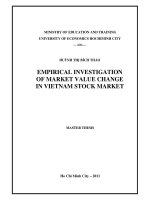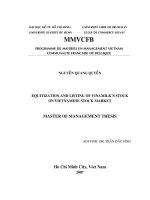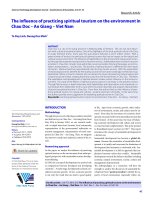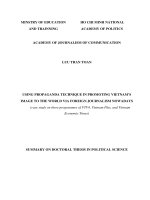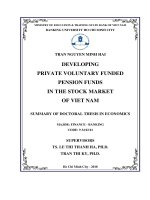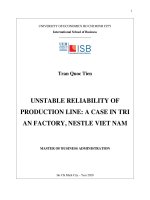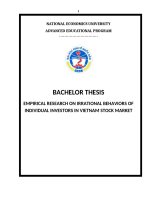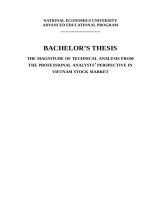Summary of Doctoral thesis in Economics: Developing private voluntary funded pension funds in the stock market of Viet nam
Bạn đang xem bản rút gọn của tài liệu. Xem và tải ngay bản đầy đủ của tài liệu tại đây (492.54 KB, 30 trang )
MINISTRY OF EDUCATION & TRAINING STATE BANK OF VIET NAM
BANKING UNIVERSITY HO CHI MINH CITY
TRAN NGUYEN MINH HAI
DEVELOPING
PRIVATE VOLUNTARY FUNDED
PENSION FUNDS
IN THE STOCK MARKET
OF VIET NAM
SUMMARY OF DOCTORAL THESIS IN ECONOMICS
MAJOR: FINANCE - BANKING
CODE: 9 34 02 01
SUPERVISORS
TS. LE THI THANH HA, PH.D.
TRAN THI KY, PH.D.
Ho Chi Minh City - 2018
i
The thesis is completed at
BANKING UNIVERSITY HO CHI MINH CITY
SUPERVISORS
1. LE THI THANH HA, PH.D.
2. TRAN THI KY, PH.D.
REVIEWER 1
REVIEWER 2
REVIEWER 3
The thesis will be examine by Examination Board of Banking University Ho
Chi Minh City at
BANKING UNIVERSITY HO CHI MINH CITY
Time & Date ........................
The thesis can be found at
THE NATIONAL LIBRARY
LIBRARY OF THE BANKING UNIVERSITY HO CHI MINH CITY
ii
LIST OF PUBLICATIONS RELATED TO THE THESIS
In the course of the thesis, a part of the dissertation was used for publication in
journals and specialized seminars in the field of economics - finance - banking in order
to increase the credibility of the thesis through the reviews of the prestigious experts
and readers.
Specific articles are as follows:
Tran Nguyen Minh Hai (2016). Developing private voluntary funded pension funds in
the securities market of Viet Nam. Financial and Monetary Market Review, Vol.
22 (463), November, 2016, pp. 21 - 27.
Tran Nguyen Minh Hai (2017). An overview of pension system reform: World trends
and in Viet Nam context. Journal of Development and Integration, Vol. 34 (44),
May - June, 2017, pp. 88 - 93.
Tran Nguyen Minh Hai (2018). The impact of private voluntary funded pension funds
on the stock market: the case of APEC economies. Proceedings of the first
international conference on Vietnam’s Business & Economics Research 2018
(VBER 2018), July 22 - 24, 2018, Ho Chi Minh City. Retrieved from
/>
1
CHAPTER 1. INTRODUCTION
1.1 Reasons for selecting the topic
For a long time, the development of financial intermediaries in the stock
market has been the subject of much research interest from theory to practice. One
of the financial intermediaries is the voluntary funded pension funds, formed from
the process of reforming the national public pension system in the context of an
aging population and gradually becoming an important large institutional investor in
the stock market. Meanwhile, in the world, the traditional PAYG pension system is
gradually being replaced by a (fully/partially) funded pension system. The
introduction of a funded pension system allows pension funds to voluntarily
accumulate funds for investment in financial markets. This accumulation is
expected to increase the depth and liquidity of the capital market. At the same time,
with their accumulated assets and long-term capital, private voluntary funded
pension funds have the incentive to invest more in long-term and illiquid assets to
generate higher returns, then they also contribute to long-term funding for the
capital market in general, the stock market in particular (Davis, 1998, Davis, 2000).
In the world, there are many empirical studies on the development of private
voluntary funded pension funds for the growth of the stock market (Catalan,
Impavido & Musalem, 2000, Walker & Lefort, 2002, Impavido, Musalem &
Tresselt, 2003; Meng & Pfau, 2010; Liang & Bing, 2010; Rocholl & Niggemann,
2010; Raisa, 2012; Hu, 2012; Zandberg & Spierdijk, 2013; Sun & Hu, 2014).
Although these empirical studies use different quantitative models in order to find
reliable estimation methods and time periods for different data sets, most
conclusions show a consistence about the meaningful positive role of private
voluntary funded pension funds in the development of the capital market.
Accordingly, these empirical studies confirm the role of institutional investors of
the private voluntary funded pension funds and the need to develop these funds in
the stock market. However, most of these empirical studies have encountered
2
limitations on the number of observable variables, namely that the available
observed time is not long enough. On the other hand, these above research focus on
the developed countries of the OECD as well as the emerging markets. According
to the Asian Development Bank (ADB), retirement markets in Asia and the AsiaPacific region are rare in existing literature (Hu, 2012).
Through this study, the topic provides new empirical evidence for the
voluntary funded pension funds’ development relationship to the growth of the
domestic securities market in APEC economies (Asian Pacific Economic
Cooperation). The research examines the impact of voluntary funded pension funds’
assets on the development of the stock market through the unbalanced panel data
collected during the period 2000 - 2015 and using macro economic - social factors
as explanatory variables for controlling in the regression models. The results show
that there is a positive relationship between the voluntary funded pension funds’
assets and the development of the stock market at a 1% significant level while other
factors unchanged in the period of 2000 - 2015. The results from the quantitative
analysis of the regression model of the author's study also confirmed the findings
from previous studies on the positive correlation between the growth of private
voluntary funded pension funds and the development of the stock market. Therefore
the author believes that the thesis will contribute to the debate on the effects of
private voluntary funded pension funds’ development on the Asian capital markets
and financial markets.
Being one of the APEC member economies, Viet Nam is a developing
country with a low average per capita income compared to other economies in the
region and in the world despite the stable GDP growth rate in recent years.
Therefore, Viet Nam is likely to face the situation of "aging before getting rich" in
the context of increasing the aging population. Therefore, ensuring social security is
an urgent issue that needs to be addressed thoroughly, including ensuring pension in
the old age. Meanwhile, the public pension system of Viet Nam operates under the
PAYG mechanism with defined benefit (DB) schemes leading high burden on
3
pension payment which is increasing significantly in the coming decades. Thus, the
public pension system of Viet Nam implies the financial instability and inequities
among generations (Giang Thanh Long, 2004). Moreover, the pressure to pay
pension is increasingly heavy on the Viet Nam Governmental budget in the future,
consequently contributing to the Governmental budget deficit, resulting in negative
impact on the overall financial situation (MOF, 2015a, Luu Hai Van, 2014).
Therefore, Viet Nam has implemented pension reforms but these reforms are
mainly in parameters (Giang Thanh Long, 2004, Dieu Ba Duoc, 2013, MOLISA,
2015).
In 2013, the Ministry of Finance's announcement of Circular No. 115/2013 /
TT-BTC guiding private voluntary funded pension insurance and vprivate voluntary
funded pension schemes in Viet Nam marked a turning point for the Vietnamese
pension system as well as introducing new financial intermediary in the role of
institutional investors in the stock market of Viet Nam. This event has shown the
interest of the Government and other stakeholders in the development of private
voluntary funded pension funds in Viet Nam stock market in order to meet the
needs of society and the market as well as contributing to the development of the
stock market since the development of Viet Nam stock market is still evaluated and
ranked low compared to other stock markets in Asia-Pacific region and in the world
(WEF, 2015) due to the quantity and quality of goods delivered (VSD, 2015) as
well as activities of market institutional participants are still very limited (SSC,
2012).
Although the development of private voluntary funded pension funds in the
stock market in Viet Nam is concerned by the Government and other stakeholders
to meet the needs of society and the market as well as contributing to the
development of the securities market, Viet Nam still lacks studies on developing
this type of fund. Most studies have been conducted after the Ministry of Finance
has issued Circular No. 115/2013/TT-BTC guiding voluntary pension insurance and
private voluntary funded pension plans/schemes in Viet Nam, focusing only on (i)
4
situation and the challenge of retirement in the context of aging populations and (ii)
the role of private voluntary funded pension funds in a multi-pillar pension system
(Dieu Ba Duoc, 2013, Khuat Thi Kieu Van, 2013; TTBD, 2014; Chi Tin, 2014; Luu
Hai Van, 2014; Nguyen Thi Le Thu, 2014, Tran Phuong Thao & Nguyen Anh
Tuan, 2014, Luong Xuan Truong, 2014, Bui Cam Huong, 2014, Thuy Duong,
2017).
Therefore, within the research scope of the thesis on developing private
voluntary funded pension funds in the stock market, private voluntary funded
pension funds are focused on analysis afor the following main reasons:
Firstly, the private voluntary funded pension fund is a long-term institutional
investor in the stock market. Voluntary pension funds have contributed to the
instistutional investor base in the development of the stock market when (i)
providing large scale, stable, long-term capital to the stock market and (ii)
simultaneously holding a large portion of financial assets as well as
constantly developing with increasing asset volume in the stock market.
Secondly, private voluntary funded pension fund is a pillar of the nation's
pension system, contributing to the improvement of pension after retirement,
contributing to social security in the context of an aging population and the
burden of the public pension system is growing.
For these above reasons, within the framework of the thesis entitled
"DEVELOPING OF PRIVATE VOLUNTARY FUNDED PENSION FUNDS
IN THE SECURITIES MARKET OF VIET NAM", the study focuses on the
systematization of the general theories related to developing private voluntary
funded pension funds, the position of private voluntary funded pension funds in a
multi-pillar pension system, criteria for evaluation as well as conditions for the
development of private voluntary funded pension funds in the stock market from
theoretical reviews to empirical evidences in order to supplement and contribute to
the understanding of the development of private voluntary funded pension funds in
5
the stock market and the development of private voluntary funded pension funds in
the stock market of Viet Nam.
In particular, the study conducted online surveys for individuals and
investors who are Vietnamese citizens and knowledgeable in the field of finance insurance in order to collect information about their choices to private voluntary
funded pension funds based on (i) the level of financial literacy and attitudes to risk;
(ii) interest and personal behavior in pension.
At the same time, the study also examines the impact of private voluntary
funded pension funds' development on the development of the stock markets of
some economies in the world, namely the APEC economies and proposes some
recommendations to develop private voluntary funded pension fund in the Viet
Nam stock market.
1.2 Research objectives and questions
1.2.1 Overall research objectives
The general objective of the dissertation is to identify the conditions for the
development of private voluntary funded pension funds in Viet Nam stock market,
thereby recommending policy implications for the development of private voluntary
funded pension funds in Viet Nam stock market.
1.2.2 Specific research objectives
To address the general research objectives, the thesis focuses on addressing
specific objectives as follows:
Analyzing the situation of pension reform in Viet Nam and developing
private voluntary funded pension funds in Viet Nam stock market.
The impact of private voluntary funded pension funds to the stock markets of
economies in the world, particularly APEC economies, in which Viet Nam is
an economy member.
Policy implications and recomendations to develop private voluntary funded
pension funds in Viet Nam stock market.
1.2.3 Research questions
6
From the specific research objectives, the thesis solves the following
research questions:
What are the conditions for developing private voluntary funded pension
funds in the stock market through the PESTLIED model? How has the
development private voluntary funded pension funds in Viet Nam stock
market been achieved?
Developing private voluntary funded pension funds in the stock market that
impacts on the development of the stock market in the economies of the
world, namely, APEC economies. What are the experience lessons learned
from empirical research on the development of private voluntary funded
pension funds in the stock market of APEC economies drawn up for the
developing of private voluntary funded pension funds in the stock market of
Viet Nam?
How are Vietnamese individuals aware of issues related to private voluntary
funded pension funds, private voluntary funded pension funds' development
in the stock market and the demand for private voluntary funded pension
funds in the stock market of Viet Nam?
From the results of research on the impact of the private voluntary funded
pension funds' development on the growth of the stock market in APEC
economies and the results of the online survey on individual needs of
Vietnamese citizens, what are the possible solutions? What are the
recommendations for developing private voluntary funded pension funds in
the stock market of Viet Nam?
1.3 Research scope and subjects
1.3.1 Research subjects
The research subject of the thesis is developing of private voluntary funded
pension funds in the stock market.
7
1.3.2 Surveyed participants
Private voluntary funded pension funds in the stock markets of selected
economies, in particular APEC economies, to consider the impact of
developing private voluntary funded pension funds on the stock market as
well as the conditions for reveloping private voluntary funded pension funds
on the stock market of these APEC economies.
Individuals and investors who are Vietnamese citizens and knowledgeable in
the finance and insurance sector in order to explore their options for private
voluntary funded pension funds and developing private voluntary funded
pension funds in Viet Nam stock market.
1.3.3 Research scope
For secondary data
The dissertation uses secondary data collected from empirical studies,
written documents, reports, and reliable sources from international organizations
such as the World Bank (WB), the International Labor Organization (ILO), the
Organization for Economic Cooperation and Development (OECD) ... updated for
the period from 2000 to 2015 on the development of private voluntary funded
pension funds in the stock market, the formation and development of the Viet Nam
stock market, the reform of pension system of Viet Nam from 2000 to 2015,
updating related information in 2016, 2017, 2018.
For primary data
For primary data sources, research conducted online surveys from February
24, 2018 to March 15, 2018 for individuals and investors who are Vietnamese
citizens and have knowledge in the field of finance - insurance to collect
information on their choices to private voluntary funded pension funds, based on (i)
level of financial understanding and attitudes toward risk; (ii) personal preferences
and behaviors in pension.
8
1.4 Research methodology
1.4.1 The approach methods
Study on the acquisition and inheritance of theories as follows: (i) the theory
of development of financial intermediaries in the stock market (David, 2000, Claus
& Grimes, 2003, Andrieş, 2009, Enache, Miloş & Miloş, 2013); (ii) stakeholder
theory (Phillips & Reichart, 2000; Freeman, Wick & Parmar, 2004; Buchholz,
2004); (iii) theory of making financial decision (Franzen, 2010); (iv) theory of longterm asset allocation (Valdés-Prieto, 2008; Viceira, 2010; Falkenheim, 2015).
These theories are also the basis for the selection of the research on the
private voluntary pension fund and the development of private voluntary pension
funds in the stock market. The study also consulted the empirical studies on the
relationship of private voluntary pension funds' development for the development of
the stock market as a reference and as a basis for comparing and contrasting survey
results and quantitative analysis results.
1.4.2 Data collection methods
For secondary data
The research is based on the collection of secondary data from reliable
sources of references from international organizations such as the WB, ILO, OECD
... and research papers published in specialized journals related to economic,
financial and insurance for the period 2000 to 2015. Secondary data is used to
consolidate the rationale since the concept of private voluntary funded pension
funds was developed and introduced in the multi-pillar pension system by WB as
well as investigated through the development of private voluntary funded pension
funds for the growth of stock markets, the conditions for developing private
voluntary funded pension funds in the stock market, particularly in APEC
economies.
For primary data
In addition, primary data is also collected through the process of surveying
individuals and investors with knowledge of finance and insurance. For primary
9
data collected through an internet survey (goo.gl/PsEzXV), the study received 223
submissions of respondents in comparison to 10,240 visits in the 24-day period
from February 24, 2018 to March 15, 2018 with 215 valid votes.
Questions were answered through personal electronic devices connected to
the internet by participants, so respondents (i) were not affected by the surveyor's
perspective; (ii) no sense of urgency or being forced into responding; and (iii)
complete anonymity when responding. Questions designed in the form of
mandatory completion if respondents want to move to the next question to help the
participant do the survey without missing out on any questions. Participants are not
paid for answering this survey. The survey consists of 32 questions divided into 4
parts: (i) personal information, including 7 questions; (ii) self-assessment of
financial literacy and risk-taking when making financial decisions in many respects,
including 9 questions; (iii) the individual's behavior, priority and level of
investment in pension with the existence of the defined contribution (DC) schemes,
including 8 questions; (iv) the current context of Viet Nam, consisting of 8
questions.
The survey respondents were individuals who were or would soon become
participants
in
private
funded
pension
plans/schemes,
including
private
occupational/employee funded pension schemes and private individual/personal
funded pension schemes alongside public unfunded pension system - Pay as You
Go defined benefit system in Viet Nam. Therefore, individuals selected for the
survey are Vietnamese citizens aged 18 years or older who have paid jobs, or are
looking for work or have listed their first job according to the study major of their
education and training.
1.4.3 Data processing methods
The research uses qualitative methods to analyze macro factors in the
PESTLIED model (Political, Economic, Sociological, Technological, Legal,
International, Environmental, Demographic factors).
10
At the same time, the study also incorporates the use of quantitative analysis
of unbalanced panel data for APEC economies between 2000 and 2015 to examine
the relationship between development ptivate voluntary funded pension funds with
the growth of the stock market in APEC economies and statistical methods that
describe the results of online surveys on the choice of individuals.
1.5 Framework of the research process
Developing private voluntary funded pension funds in the stock market
The need to developing private voluntary funded pension funds in Viet Nam stock market
Research problem
Developing private voluntary funded pension funds in Viet Nam stock market
Identifying the conditions for the development of private voluntary funded pension funds in Viet Nam stock
market, thereby recommending policy implications for the development of private voluntary funded pension
funds in Viet Nam stock market.
Research methodology
- Approach methods: Theory of financial intermediation development on the stock market, stakeholder
theory, behavioral finance theory, long-term asset allocation theory, and domestic and foreign empirical
studies on developing private voluntary funded pension funds in the stock market.
- Data collection methods: Secondary data from international organizations WB, ILO, OECD ..., primary
data from online surveys of individuals who are Vietnamese citizens.
- Data processing methods: Combination of qualitative analysis (PESTLIED model, descriptive statistics ...)
and quantitative analysis (Pooled OLS, FE, FE - cluster, RE) .
Research content
Describing the conditions for the development of private voluntary funded pension funds in Viet Nam stock
market using the PESTLIED model; Determining the impact of developing private voluntary funded pension
funds in the stock market and the conditions for developing private voluntary funded pension funds in the
stock market of APEC economies by estimating the regression model by the method Pooled OLS, FE, FE cluster, RE; Statistically describing the understanding and needs of individuals who are Vietnamese citizens
on issues related to private voluntary funded pension funds, the development of private voluntary funded
pension funds in the Viet Nam stock market.
Proposing some solutions on the conditions for developing private voluntary funded pension funds in Viet
Nam stock market to contribute to the development of Viet Nam stock market, Viet Nam economic growth.
11
1.6 New contributions
The thesis presents the conditions for the development of private voluntary
funded pension funds in the Viet Nam stock market using the PESTLIED
model, which summarizes the trend of pension reform in Viet Nam, analyzes
the current situation of developing private voluntary funded pension funds in
the stock market of Viet Nam.
The thesis evaluates the impact of developing private voluntary funded
pension funds on the development of stock market in APEC economies, and
the empirical results of the empirical study show the impact of private
voluntary funded pension funds's development to the development of the
stock market in APEC economies.
The thesis examines individuals who are Vietnamese citizens to analyze their
attitudes toward risk acceptance, the level of understanding of private
voluntary funded pension funds, the conditions for developing private
voluntary funded pension funds in the stock market of Viet Nam.
The thesis analyzes the prospect of developing private voluntary funded
pension
funds
in
Viet
Nam
stock
market
and
proposes
some
recommendations on the conditions for developing private voluntary funded
pension funds in Viet Nam stock market.
1.7 The composition of the thesis
To reach the research objective, the thesis is shown in the configuration 5
chapters with the list of references and 7 appendice in order to strengthen the
contents of thesis.
12
CHAPTER 2. LITERATURE REVIEWS ON DEVELOPING
OF PRIVATE VOLUNTARY FUNDED PENSION FUNDS IN
THE STOCK MARKET
2.1 The pirvate voluntary funded pension fund
The concept of private voluntary funded pension fund implies the type of
pension fund to be fully funded based on the voluntary contributions of people
participating in private pension plans/schemes in relation to the public compulsory
unfunded pension fund (unfunded and managed by the public sector - the PAYG
system) (Blommestein, 1997; OECD, 2004).
Private voluntary funded pension funds are the third pillar in the multi-pillar
pension system introduced by the WB in 1994, including:
(i) a private employee/occupational voluntary funded pension fund which can be
based on a defined benefit (DB) or a defined contribution (DC) model: A
private voluntary funded pension fund may have contributions from the
employer and is a type of pension fund under a contract signed by the fund
management company and employers who represent employees participating
in the contract, but employees have the right not to participate and are not
obliged to participate in this contract (GoC, 1999; OECD, 2004; NBS, 2011;
OECD, 2011).
(ii) Private personal/individual voluntary funded pension based on the defined
contribution (DC) model: Private voluntary personal funded pension funds
are established by financial institutions (such as banks, life insurance
companies) and applied to all individuals, operating within the framework of
the legal regulatory system like investment funds in the market and
encouraged by the government's tax incentives (WB, 1994, WB, 2008).
Private voluntary funded pension funds are mainly managed by the private
sector, which are funded by voluntary contributions from participants under the
13
agreements specified in the contracts of pension plans/schemes based on DB or DC
model. The development of private voluntary funded pension funds has been
accompanied by a shift towards a transition from DB to DC model (WB, 1994,
Blommestein, 1997, OECD, 2004, WB, 2008, Hinz, Rudolph, Antolín & Yermo,
OECD, 2011; Holzmann, 2012; Mishkin, 2012).
2.2 Criteria for assessing the development of private voluntary funded
pension funds in the stock market
In most empirical studies, the volume of the private voluntary funded
pension fund's assets is the most commonly used proxy to measure the development
of private voluntary funded pension funds in the stock market. And for the level of
development of the stock market, it is usually expressed through two indicators: (i)
the depth of the stock market; and (ii) liquidity of the stock market (Catalan,
Impavido & Musalem, 2000, Walker & Lefort, 2002, Impavido, Musalem &
Tresselt, 2003, Davis & Hu, 2008; Raddatz & Schmukler, 2008; Hryckiewicz,
2009; Kim, 2010; Meng & Pfau, 2010; Liang & Bing, 2010; Rocholl & Niggemann,
2010; Raisa, 2012; Hu, 2012; Zandberg & Spierdijk, 2013; Sun & Hu, 2014).
2.3 Developing the private voluntary funded pension funds in the stock
market
Developing private voluntary funded pensiopn funds in the stock market has
become an important objective trend and is encouraged in the process of developing
financial movements of countries around the world in order to:
Increasing total savings to meet social needs and market requirements
Developing institutional investors in the stock market
Providing stable and long-term capital in the stock market
Increasing the depth and liquidity of the stock market
2.4 Conditions for the development of private voluntary funded pension
funds in the stock market
As any institutional investor in the stock market, the development of private
voluntary funded pension fund in the stock market is also influenced by the
14
objective conditions of economic - political - social -cultural factors, technological
advances in the macro environment and internal micro-elements of private
voluntary funded pension funds. However, with regard to pension and voluntary
contributions from pension plan/scheme participants, the conditions to develop
private voluntary funded pension funds in the stock market revolve around the basic
features are synthesized and analyzed according to the PESTLIED model.
In which, external macro-economic factors, including (i) inflation and
macroeconomic stability; (ii) modernizing the infrastructure of the stock market;
(iii) legal regulations on investment activities and asset allocation are the conditions
under which the empirical studies on the development of private voluntary funded
pension funds in the domestic stock market in the world are accepted its importance
for the developing private voluntary funded pension funds in the stock market
(Fischer & Reisen, 1994; Blommestein, 1997; Vittas, 2000; Impavido, Musalem &
Tresselt, 2003; Hryckiewicz, 2009; Kim, 2010; Rocholl & Niggemann, 2010, Raisa,
2012).
15
CHAPTER 3. DEVELOPING PRIVATE VOLUNTARY
FUNDED PENSION FUNDS IN THE STOCK MARKET:
EXPERIENCE LESSIONS FROM APEC ECONOMIES
3.1 Background
In the APEC economies, in the period 2000 - 2015, the average annual
growth rate of private voluntary funded pension fund is higher than the annual
average growth rate of domestic capital market, except in Thailand, Singapore,
Philippines and Indonesia. As the results, the figures from 2000 to 2015 show the
spectacular growth of private voluntary funded pension funds in the world in
general and in APEC economies in particular. Private voluntary funded pension
funds have increased by an average of 5,5% per year between 2000 and 2015 in
terms of asset volume, while market capitalization of APEC economies has been on
average 3% per year.
Consequently, does the private voluntary pension funds' volume increase
contribute to the development of the stock market in APEC economies in the period
2000 - 2015? Which recommendations could be made for the formation and
development of private voluntary funded pension funds in Viet Nam? This problem
leads to the quest for answers through the process of conducting empirical research
of this study.
In most empirical studies on developing private voluntary funded pension
funds in the stock market, beside the volume of private voluntary funded pension
funds that represents the development of private voluntary funded pernsion funds,
measurable factors concretize the conditions affecting the development of private
voluntary funded pension funds as well as the development of the stock market,
which are usually selected for analysis such as (i) the inflation rate; (ii) long-term
interest rates in the government bond market; (iii) GDP per capita; (iv) economic
freedom index; (v) the proportion of older people per 100 people in working age ...
16
(Impavido, Musalem & Tresselt, 2003; Hryckiewicz, 2009; Kim, 2010; Rocholl &
Niggemann, 2010; Raisa, 2012).
3.2 Data sources
From the reference to the major foreign experimental studies, the study also
selected the most frequently used variables, with the most frequently mentioned,
including the 7 measurable variables representing conditions for developing private
voluntary funded pension funds in the stock market as well as the growth of dtock
market in order to implement a regression model to analyze the impact of private
voluntary funded pension funds's development on the growth of the stock market.
Thus, in order to contribute to the role and assessment of the long-term
institutional investors' impact, namely private voluntary funded pension funds, to
the development of the stock market, this study focused on the scope of APEC
member economies during the period from 2000 to 2015 with secondary data
accessed from open sources by international organizations such as APEC, OECD,
WB, WEF. This data set is a short panel data due to T N and an unbalanced panel
data due to unpublished data, which is the missing value resulting in cross-sections
not having the same number of observations over time.
3.3 Regression models
The overall regression model was applied for the panel data to examine the
impact of private voluntary funded pension funds’ development on the development
of the stock market is described as follows:
MK i ,t i i ,t 1 LTRi ,t 2 GDPPi ,t 3 EFi ,t 4 OADR i ,t 5 PFAi ,t i ,t
In which,
MK i ,t represents the development of the stock market as a dependent variable
and is calculated by the market capitalization of domestic listed companies (% of
GDP) of the economy i at the time of the year t ; PFAi ,t epresents the development
of private voluntary funded pension funds as an independent variable, measured by
17
the private voluntary funded pension fund’s asset value (% of GDP) of the economy
i at the time of the year t .
In addition, in order to control the explanatory variables that may affect the
development of the domestic capital market, the author focuses on the following
variables, including: i,t is the variable that explains the inflation rate (%) of the
economy i at the time of the year ; LTR i ,t is a variable that explains the market
demand for government bonds that have a maturity of 10 years (%) of the
economy i at the time of the yea r t ; GDPPi ,t is the variable that explains GDP per
capita of the economy i at the time of the year t ; EF i ,t is the variable that explains
the economic freedom index of the economy i at the time of the year t ; OADR i ,t is
the proportion of elderly dependents aged 65 and over per 100 people in working
age of the economy i at the time of the year t ; i are the particular unobserved fixed
effects of
the economy i ; i,t is a random error with i and t represent the
corresponding economy and time dimension.
3.4 Variable descriptives
(i) MK : Market capitalization of domestic listed companies (% of GDP)
The market capitalization (also known as market value) is the current price
of a common stock multiplied by the number of ordinary shares in circulation
(outstanding shares). Valuable data is recorded at the end of the year and collected
from domestic listed companies. Data from investment funds, trust funds and
companies with a business objective of holding shares of other listed companies are
excluded. This criterion represents the depth of the stock market (Catalan, Impavido
& Musalem, 2000; Impavido, Musalem & Tresselt, 2003; Hryckiewicz, 2009; Kim,
2010; Rocholl & Niggemann, 2010; Raisa, 2012).
(ii) : Inflation rate (% / year)
The inflation rate measured by the consumer price index reflects the
percentage change in the annual cost to the average consumer buying a basket of
goods and services that can be fixed or variable annually. Accordingly, Laspeyres
18
formulas are commonly used and also apply to data on inflation rates collected in
this study.
(iii) LTR : Long-term interest rate in 10 - year government bond market
(%/năm)
LTR is mainly determined by (i) the price charged by the lender, (ii) the risk
from the borrower, and (iii) the decrease in the value of the loan. Data collected for
long-term interest rates are calculated as the average of daily interest rates, and the
unit of measure is expressed as a percentage. LTR is the interest rate at which
government bond prices are traded on the financial market rather than the interest
rate at which loans were issued. LTR is therefore used to measure the effect of
changes in the market interest rate of return on bond holdings (alternative financial
instruments compared to stocks in the market).
(iv) GDPP : Real GDP per capita (current USD currency)
The GDPP data collected from WB’s calculated data as the GDP divided by
the mid-year population. In particular, GDP is the gross value added of all resident
producers in the economy plus product taxes and minus subsidies not included in
the value of the product. In addition, one point to note is that GDP is calculated
without a deduction for fixed asset depreciation or for depletion and degradation of
natural resources. The GDPP data collected is in current USD currency.
(v) EF : Economic freedom index (points)
The economic freedom index EF assesses 10 basic elements of each
economy, including business freedom, trade liberalization, financial freedom,
government spending, monetary freedom, financial freedom, property rights,
freedom from corruption, labor freedom. With a score of 100 being the maximum
freedom for each factor to be evaluated, score 100 implies the economic
environment or economic policy that is most conducive to economic freedom. In
this study, the level of general economic freedom is simply calculated from the
mean of the 10 basic elements and chosen to be the value of explanatory variable
EF .
19
(vi) OADR : The percentage of elderly dependents per 100 persons of
working age
This ratio of population aging is calculated based on the ratio of the
population aged 65 and over (the age at which the worker is economically inactive)
compared to people aged 15 to 64 years. The value of data collected is expressed in
units of 100 people in working age (from 15 to 64 years).
(vii) PFA : Pension funds’ assets (% of GDP)
PFA is defined as a property purchased with contributions to a pension plan
solely for the purpose of financing pension plan benefits. In it, a private voluntary
funded pension fund is a set of assets that constitute an independent legal entity.
This indicator is in US $ million or as a percentage of GDP.
3.5 Data processing methods
The estimation by using simple linear regression models for panel data
model can be conducted through the use of three methods: (i) with the general
constants in the regression equation; (ii) fixed effects; (iii) random effects.
3.6 Empirical results
Table 3.4 Statistical descriptives of variables in the sample period 2000 - 2015.
Variable
Obs
Mean
Std. Dev.
Min
Max
MK
151
65,64896
29,70931
14,01656
118,1327
151
3,125655
2,426735
-1,346719
15,52533
LTR
151
5,246457
2,77952
0,3466667
15,68075
GDPP
151
19.9947,82
17.387,59
958,0116
67.652,68
EF
151
68,15533
9,995838
50,3
87,4
OADR
151
15,83827
7,939747
5,598219
43,32391
PFA
151
23,93331
27,71412
0,305036
118,7
Source: Extracted from Stata 11.
Table 3.5 The matrix of correlation between the variables.
MK
LTR
EF
GDPP
OADR
MK
1,000
-0,3751
1,000
PFA
20
0,0000
LTR
GDPP
EF
OADR
PFA
-0,5244
0,6834
1,000
0,0000
0,0000
0,4202
-0,4623
-0,5767
0,0000
0,0000
0,0000
0,4231
-0,4602
-0,3826
0,7164
0,0000
0,0000
0,0000
0,0000
0,3434
-0,4615
-0,6610
0,7611
0,4631
0,0000
0,0000
0,0000
0,0000
0,0000
0,6217
-0,2472
-0,3381
0,6956
0,7037
0,3906
0,0000
0,0022
0,0000
0,0000
0,0000
0,0000
1,000
1,0000
1,0000
1,0000
Source: Extracted from Stata 11.
In addition, to determine whether multi-collinearity exists, the Variance
Inflation Factor (VIF) test was conducted to test for panel data by Collin's command
in Stata 11. The results of the VIF test showed that all coefficients were less than 10
(Mean VIF = 3,22), which means that multiplicity was not found in the study
population (Kennedy, 1992).
Table 3.6 A summary of the results of the voluntary retirement fund
development to the stock market with OLS, FE, FE-cluster and RE models.
Variable
OLS
FEM
FEM-cluster
REM
-0,8813978
-2,155102**
-2,155102*
-1,778959**
0,387
0,011
0,055
0,031
1,016
0,839
1,035
0,826
-4,598254***
-4,785188***
-4,785188***
-4,578459***
0,000
0,000
0,000
0,000
0,993
0,904
0,734
0,882
-0,0006348***
-0,0006722***
-0,0006722*
-0,0009343***
0,003
0,009
0,060
0,000
0,000
0,000
0,000
0,000
-0,1277528
-0,7771847
-0,7771847
0,1497132
0,649
0,319
0,342
0,750
0,279
0,777
0,792
0,469
0,1637325
2,098729***
2,098729***
1,20526**
LTR
GDPP
EF
OADR
21
PFA
Constant
R-squared
0,661
0,001
0,008
0,019
0,372
0,646
0,680
0,513
0,7826034***
0,0114778
0,0114778
0,551053***
0,000
0,963
0,970
0,001
0,097
0,249
0,299
0,171
92,57421***
130,3531**
130,3531**
72,71303**
0,000
0,010
0,011
0,017
18,755
49,588
45,257
30,334
R-squared 0,5472
within = 0,3518
within = 0,3518
within = 0,3188
Adj R-squared
between = 0,0071
between = 0,0071
between = 0,6337
overall = 0,0877
overall = 0,0877
overall = 0,4709
151
0,5284
Observations
151
151
151
F test that all β=0
F( 6, 144) = 29,01
F(6,129) = 11,67
F(6,15) = 34,68
Prob>F
Prob>F = 0,0000
Prob>F = 0,0000
Prob>F = 0,0000
Wald
(chi2)
Wald chi2(6) =
Prob> Chi2
82,31
Prob > chi2 =
0,0000
Breusch
and
chi2(1) = 192,56
Pagan test Prob>
Prob > chi2 =
Chi2
0,0000
F
test
that
all
F(15, 129) = 11,76
u_i=0
Prob > F = 0,0000
Prob>F
Hausman
test
chi2(5) = (b-
Chi2 Prob>Chi2
B)[(V_b-V_B)^(1)](b-B) = 10,45
Prob>chi2 = 0,0636
Wald
test
for
chi2 (16) = 390,65
heteroskedasticity
Prob>chi2 =
Chi2 Prob>Chi2
0,0000
Wooldridge
test
F( 1, 13) = 3,428
for autocorrelation
Prob > F = 0,0870
The results are presented in each of the variables in the model order in turn: (i) the mean value of the
coefficient; (ii) statistic significance level (P-value) and (iii) standard error;
* Statistically significant at 10%; ** Statistically significant at 5%; *** Significant at 1%.
